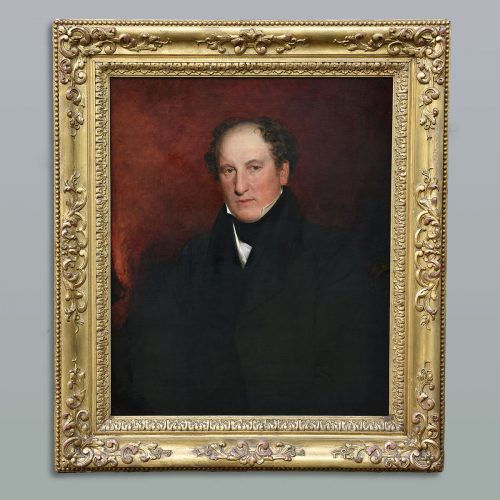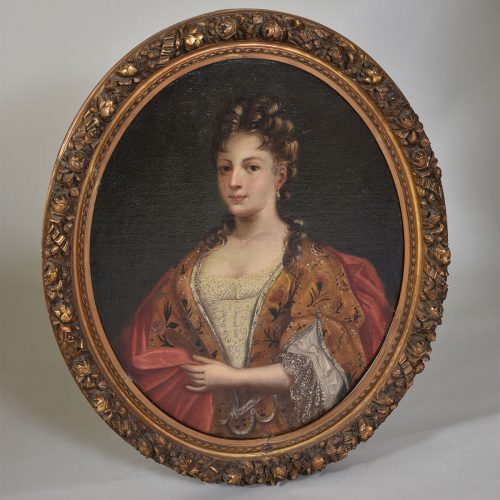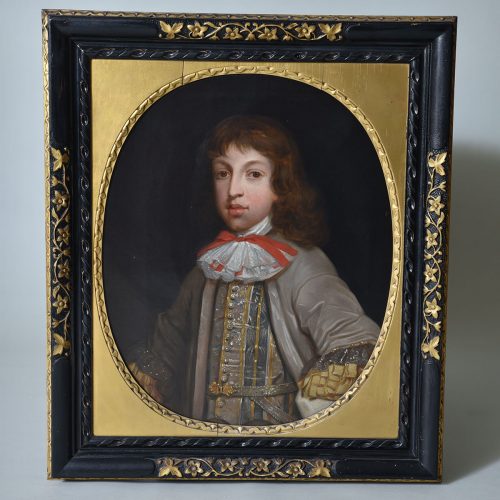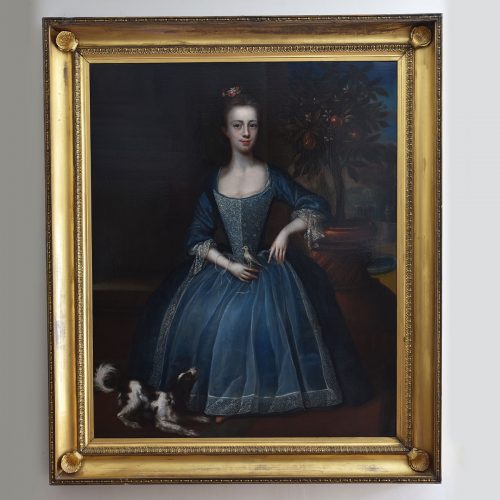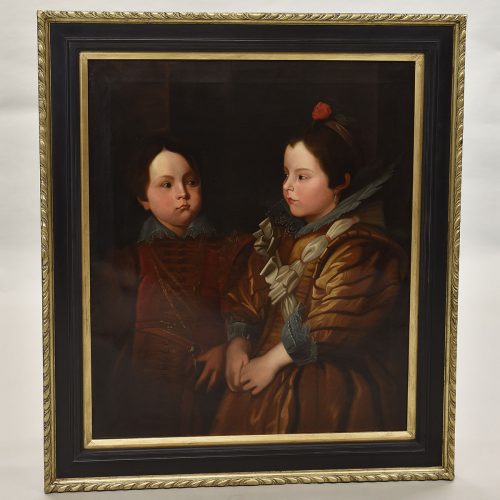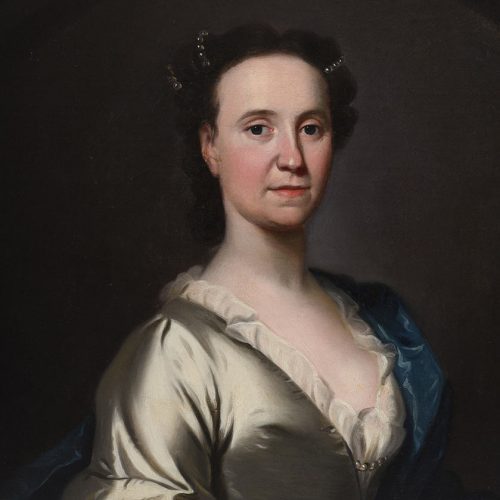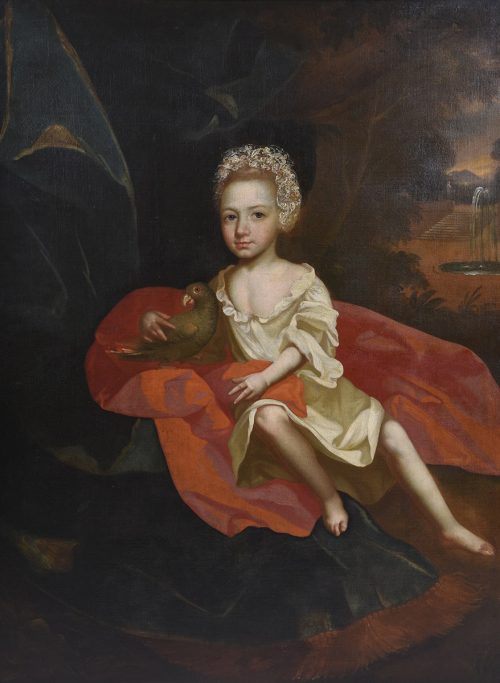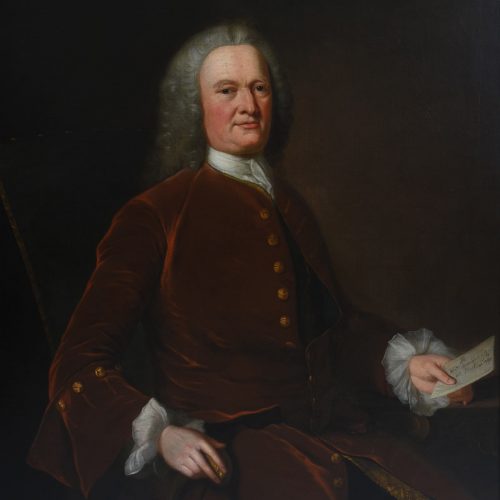Portraits
-
Portrait of a Gentleman
£2,950.00Oil on canvas in carved and gilded frame. Portrait of Charles Goodall, founder of Charles Goodall and Sons. The company were the largest producers of playing cards in the 19th century, making three quarters of all those made This portrait hung in the Goodall factory from around 1840 until the closure of the works in 1922. It was subsequently kept in the family until recently. Relined. Framed Size: Width: 34" / 86 cms Height: 39.5" / 100 cms -
SOLD
17th century Portrait
£3,250.0017th century oil on canvas of a French Noblewoman (possibly Madame de Cavalliere). Ornate hand carved and gilded oval frame Circle of Pierre Mignard (1612-1695) Mignard was one of the most successful artists in 17th century France, being commissioned by Louis XIV, who gave him the opportunity to paint many of the court figures. Framed Width: 32" / 82 cms Framed Height: 38" / 97 cms -
17th century Portrait of a Gentleman
£2,950.0017th century Portrait of a Gentleman. Oil on Canvas. Carved and Gilded Frame. School of Kneller (1646-1723) On the reverse, said to be of John Verney, (1652-1707), MP for Leicestershire. 1st son of Sir Richard Verney of Compton Verney, Warwickshire. Brother of George Verney, who became Lord Willoughby de Broke in 1711 and later Dean of Windsor. Width: 32" / 81 cms Height: 37" / 94 cms -
17th century Portrait
£2,850.00Portrait of Charles Howard of Greystoke Castle Oil on Canvas in Ebonised and Giltwood Frame Charles Howard (1630-1713) of Greystoke Castle, Cumbria. Painted here as a boy. Charles was the fourth son of Henry Frederick Howard, 15th Earl of Arundel and Elizabeth Stuart. Although it was his father’s wish that he would inherit the title, Duke of Norfolk, his brother Henry obstructed this. Charles sued Henry through the House of Lords but the case was not resolved in his lifetime. Width: 30" / 76 cms Height: 36" / 92 cms -
Oil on Canvas in Giltwood Frame Attributed to Joseph Highmore (1692-1780) Portrait of a young lady in blue lace bodice, holding a bird with her King Charles spaniel at her feet. Highmore was educated at Merchant Taylors School and studied to become a lawyer. He abandoned this for painting and trained at St Martin’s Lane Academy and set up practice in 1715. He continued to study in Godfrey Kneller’s Academy and became one of the most accomplished portrait painters of his age. Highmore was capable of painting with the greatest refinement. Provenance: The Priory, Isle of Wight. Represented at The National Portrait Gallery, London, The Tate, Yale Width: 50" / 127 cms Height: 60" /152 cms
-
17th century Portrait of Children
£2,500.0018th century portrait of the younger children of Giacomo Lomellini, Doge of Genoa 1625-1627 - After Van Dyke The original version of this painting by Van Dyke of the family hangs in the National Gallery of Scotland and is considered as being one of his finest works. Doge Lomellini was famous for implementing a famous defence project of the capital of Genoa - a substantial city wall from the San Benigno hill at the mouth of the Bisagno stream, a work that was the basis of the "New Walls". In December, 1626 the doge laid the foundation stone and in the following years there were many donations from individuals, corporations, and the arts, to which were added the new taxes specifically designed to support the walls’ construction, paid for by the middle and less wealthy classes. The amount collected, approximately 2,100,000 Genoese pounds, did not serve to cover the entire construction, but was the basis for starting the works. His term as Doge ended on 25 June 1627, and Lomellini was elected from January 1628 to 1630 as head of the war magistrate. In 1634 he was in the office of the magistrate of Corsica and in 1637, and again in 1644, he led the commission of the State Inquisitor of the Republic of Genoa. In 1645 and until his death he took part in the direction of the restoration and modification of the Doge's Palace. Lomellini died in Genoa on April 1, 1652. Anthony Van Dyke (1599-1641) – Born in Antwerp to prosperous parents. Antoon van Dyck’s talent was evident and he became an independent painter around 1615, setting up a workshop with Jan Breugel the Younger. Within a few years he became the chief assistant to Peter Rubens, the dominant master painted of the whole of Northern Europe. He lived a good part of his early life in Genoa, although he moved to London to be granted citizenship by Charles I who commissioned Van Dyck to paint several portraits. The portrait of Charles I in three positions (1635-36) is one of the most famous images. Width: 33" / 84 cms framed size Height: 39" / 97 cms -
Late 17th century portrait of a gentleman - in carved and gilded frame Width: 27" / 69 cms framed size Height: 32.5" / 83 cms
-
SOLD
Portrait of a Young Man
£1,850.00Oil on Canvas. Attributed to Theophilus Clarke (1776-c.1832) Original Giltwood Frame. Portrait of Charles Gordon as a young man, dressed in fashionable Georgian attire. Provenance: Property of the Morland Family, Court Lodge, Kent Width: 28" / 71 cms Height: 33" / 84 cms -
SOLD
Pair of 18th century Portraits
£5,250.00Portrait of William Matson - Circle of William Hoare of Bath (1706-1790/99) Oil on Canvas in Period Carved Wood Gilded Frame William Matson (1719-1764) - The Matson Family resided at Titup Hall in Dalton-in-Furness, Lancashire. William married Ann , the daughter of Jacob Morland of Capplethwaite. Their grave stone can be found in the Kendal Parish Church. Williams Hoare of Bath R.A. - From an early age Wm Hoare excelled in Art. In the the early 1720's he studied under Grisoni, and later in Rome under Imperiali (who taught Ramsay and Batoni) By 1739 Hoare had settled in Bath where he established a highly successful practice painting portraits in the mediums of crayon and oil. The influential Duke of Newcastle became his patron. He exhibited 22 times at the R.A. Hoare's work is represented in the National Portrait Gallery and the National Gallery of Scotland. Provenance: The Morland Family at Court Lodge, Lamberhurst, Kent Width: 30" / 76 cms Height: 35" / 89 cms -
Pair of 18th century Portraits
£5,750.00One of a Pair of 18th Century Portraits - Oil on Canvas - Attributed to Joseph Highmore (1692-1780) Portrait of Ann Morland (1709-1791) in Period Giltwood Frame Anne Morland was the second daughter of Jacob Morland of Capplethwaite, Cumbria. Her father was a Justice of the Peace and a well known portrait of Jacob Morland with his dog, painted by George Romney in 1763, hangs in the Tate Gallery, London. Ann married William Matson of Titup Hall, Barrow in Furness, Lancashire. They had two children, Margaret and Ann - the latter married Tomas Morland (to whom we think she was related). They lived at Court Lodge, Lamberhurst, Kent. Joseph Highmore was educated at The Merchant Taylors School, London. He began his career as a lawyer but abandoned this to study art at Sir Godfrey Kneller's Academy. Highmore established a very successful practice as a portrait painted in 1715 and was described by George Vertue as being 'distinguished in the first class of those who make the best figure'. His works are represented at The National Portrait Gallery and The Tate Gallery, London Provenance: The Morland Family, Court Lodge, Lamberhurst, Kent Width: 30" / 76 cms Height: 35" / 89 cms -
18th century Portrait of Girl
£4,850.00Large 18th century Portrait - Oil on Canvas - Young girl seated with a parakeet - a country house in the background - a fountain playing in formal grounds Width: 46.5" / 118 cms Height: 56" / 142 cms -
SOLDPortrait of a William Morland Esq (1692-1774) - Circle of Thomas Hudson (1701-1779) William Morland is shown holding the deeds to Court Lodge - inscribed on the letter in the Sitter's left hand. William Morland of the village of Morland in Westmorland purchased Court Lodge in 1733. He demolished the existing house and rebuilt it in the Queen Anne style in stone quarried from the ground. The Morland family became the Lords of Lamberhurst Manor and remained so until 1935. Thomas Hudson was considered, along with Allan Ramsay, to be one of the most fashionable and accomplished painters of portraits in London during the period 1730-1740. Width: 47" / 120 cms - Framed Size Height: 57" / 145 cms


